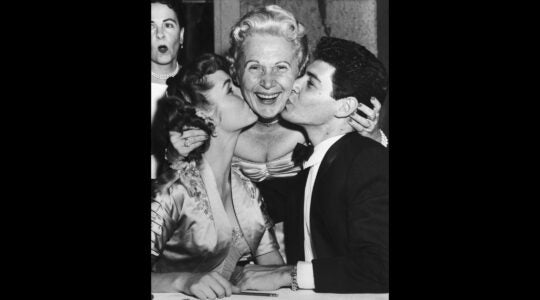Its creative ranks include recluses, the insane and former prison inmates, but "Outsider Art" is hardly the exclusive domain of social misfits.
A tour through the American Museum of Folk Art or any number of galleries specializing in what is also known as "self-taught art" exposes viewers to a rich field of artists – including a notable number of Jewish painters – who, while untrained, display a talent for visual expression appreciated by connoisseurs and common folk alike.
The French painter Jean Dubuffet first coined the term "Art Brut" in 1945 to describe the "pure raw creation" made by children, the mentally ill and other people "unharmed by artistic culture." But since the discovery of Grandma Moses by The Galerie St. Etienne in 1940 and the opening of Phyllis Kind’s gallery in Chicago, a showplace for early Outsider Art, in 1967, art created outside of the formal academy has increasingly attracted institutional and private collectors.
A major sign of mainstream acceptance came this week with the first-ever sale devoted to Self-Taught and Outsider Art by a major auction house. The sale Monday at Christie’s brought in just over $1 million. Most of the 120 works on offer came from the collection of New York media mogul Richard M. Greenberg, one of a handful of prominent private collectors in the field.
Elsewhere, evidence of Outsider Art’s ascendance is visible at the Whitney Museum of American Art, where quilts sewn by women of rural Alabama are on view through March 2. The fantasy-based mural-sized watercolors of Henry Darger, a reclusive Chicago artist who died in 1973, form a cornerstone of the Folk Art museum’s permanent collection. Other works prominently displayed in the Midtown museum’s prize-winning building include two of the best-known Jewish artists in the field, Morris Hirshfeld and Harry Lieberman.
"There’s a growing appreciation for great art, be it musical or visual, coming from any number of sources," said Selig Sacks, a New York lawyer and art collector who was one of 10,000 visitors attending last weekend’s Outsider Art Fair in Soho. Sacks first got hooked 15 years ago when he saw painter Purvis Young’s rough-hewn chronicles of African-American life in South Florida.
Walking among the booths set up this year in the Puck Building by 32 galleries from as far as Iowa City and Strasbourg, France, Sacks found numerous examples that exhibited the "creative genius," a "singularity of vision" and a skillful articulation of line and form he admires.
He stopped to take in the work of some of his favorite artists, including French Jewish artist Michel Nedjar, who fashions cloth "poupees" (creatures made from discarded cloth and other materials), as well as self-taught celebrities like the collagist William Hawkins and James Castle, the deaf, mute and illiterate artist who drew detailed interiors using charcoal from the family stove.
Castle was introduced to audiences at the annual fair five years ago. This year, it was Janet Sobel’s turn. A Jewish housewife from Brooklyn, the mother of five took up painting in 1937 at the age of 43. She was briefly acknowledged in the mid-1940s for her drip paintings, was the subject of a solo exhibition at Peggy Guggenheim’s gallery and was even recognized as a precursor to the Abstract Expressionist painter Jackson Pollock.
A photograph of Sobel captures her in the midst of creation – sprawled on the living room floor, one foot pointing up to the ceiling, and surrounded by her brightly colored canvases, including what appears to be a Jewish wedding.
Sobel had fallen into obscurity until New York gallery owner Gary Snyder visited her Baltimore home and discovered "an incredible body of work – in the basement," said Kristen Accola, Snyder’s wife and business partner.
Many self-taught artists are secretive about their work, making phenomenal discoveries common. The Alabama artist Thornton Dial buried his assemblages of found objects because he mistakenly thought he needed a special permit to make them. Some of those works were included in last year’s Whitney Biennial.
Joseph Garlock, the son of a Jewish rabbi from a village near Minsk, took up painting as a hobby at age 65. His prolific body of paintings was found covered in grime in the chicken coop outside his summer home in Woodstock.
A "rescue operation" by the Chelsea gallery Ricco/Maresca Gallery revealed vigorously rendered landscapes and scenes of daily life, painted on a variety of surfaces, including wooden boards and cardboard from department store boxes. Some of Garlock’s large canvases were priced at between $4,000 and $7,500 at the Outsider Art Fair.
Like Garlock, many self-taught artists picked up painting late in life to satisfy pent-up creative urges or to stave off loneliness. Brooklynite Aaron Birnbaum, for example, took up painting in his mid-60s when his wife, Sadie, died. Having retired from the garment industry, Birnbaum turned his pastime into a second career, which continued until a stroke stopped him at nearly 102.
The Folk Art museum celebrated Birnbaum’s 100th birthday, and the Aldrich Museum in Ridgefield, Conn., held a one-man show of his memory paintings of scenes from childhood in Eastern Galicia and others drawn from a repeating palette of templates: birds, dogs, houses, ships.
Skeptics question the need to distinguish between self-taught, outsider or visionary art and the work of recognized fine artists. Others point to the fact that one-time "outsiders" now have gallery representation or exhibitions at major art museums.
Those who appreciate visionary art refer to its essential quality of authenticity. Baltimore’s seven-year-old American Visionary Art Museum, for example, is entirely devoted to art by self-taught individuals whose work "begins by listening to the inner voices of the soul."
Collectors and dealers defend the right of self-taught artists to profit from their talents.
"It’s sad that we are saying for the first time: Wait a minute. If people know who you are, you are no longer outside," said Judy Saslow, a gallery owner in Chicago who sells Michel Nadjar’s paintings. "It’s criminal to suggest that people not reap the benefits of their endeavors."
Said Luise Ross, whose booth at the Puck Building featured fantasy paintings of Samuel Rothbort (1882-1971) and intricate wooden carvings by New Jersey junkyard proprietor Albert Hoffman, who died in 1993 at the age of 88: "Not everyone who wants to make art enrolls in the School of Visual Arts."
"Aaron Birnbaum: Classic Paintings" through Feb. 8 at K.S. Art, 73 Leonard St., Manhattan, (212) 219-9918. Tues.-Sat., 11 a.m.-6 p.m. "Inside Out: Selected Works by Janet Sobel" through March 22 at Gary Snyder Fine Art, 601 W. 29th St., Manhattan, (212) 871-1077, Tues.-Fri., 10 a.m.-6 p.m.; Sat. 10 a.m.- 5p.m. American Folk Art Museum, 45 W. 53rd St., Manhattan, (212) 265-1040. Tues.-Thurs., Sat.-Sun., 10 a.m.-6 p.m.; Fri., 10 a.m.-8 p.m. $9, $5. Free admission Fri., 6-8 p.m. "The Quilts of Gee’s Bend" through March 2 at the Whitney Museum of American Art, 945 Madison Ave., Manhattan, (800) WHITNEY. Sat.-Sun. and Tues.-Thurs., 11 a.m.-6 p.m.; Fri., 1-9 p.m. $12, $9.50. Pay what you wish Fri., 6-9 p.m.
The New York Jewish Week brings you the stories behind the headlines, keeping you connected to Jewish life in New York. Help sustain the reporting you trust by donating today.




